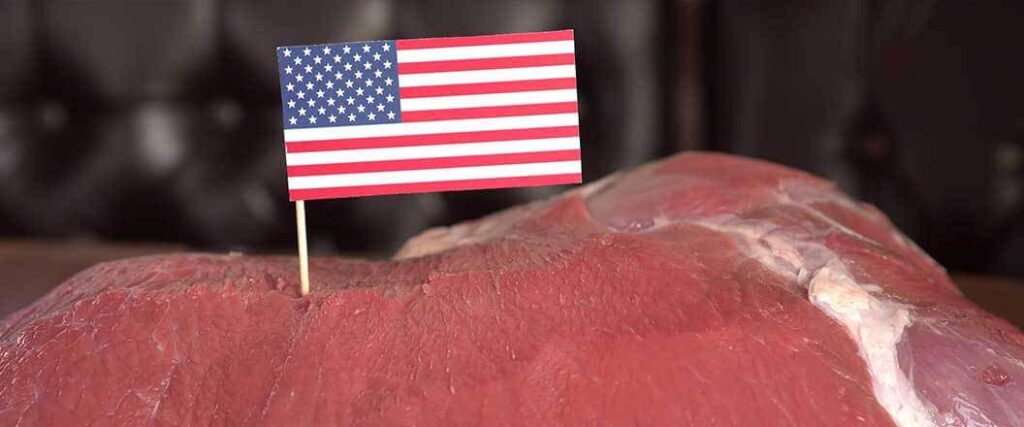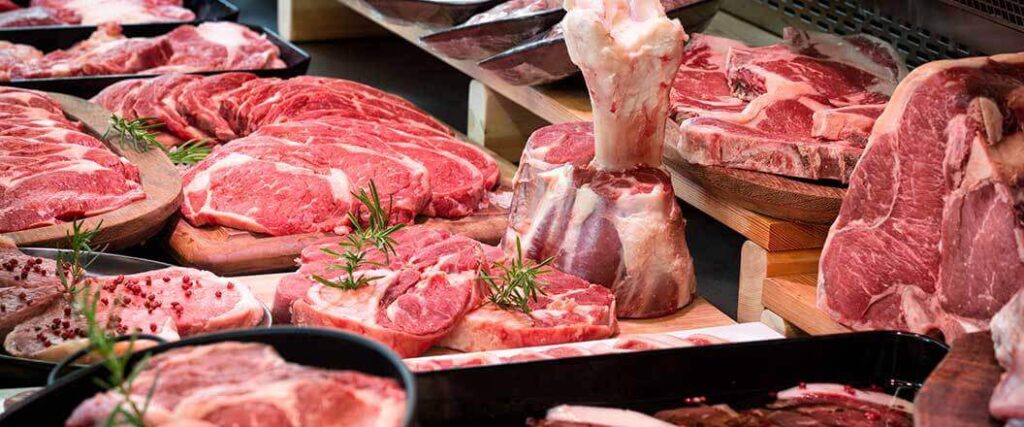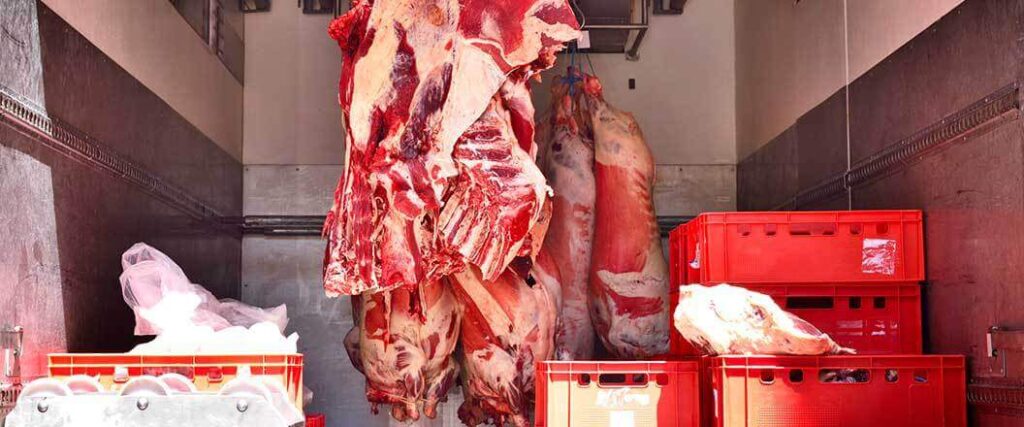There is a reason cowboys and the images of the United States tend to go together. When it comes to exporting beef, few nations can compete with the thousands of ranches across the United States and the cattle that they raise. That many cows mean we process large quantities of beef and beef products in high demand as exports.
The U.S. Department of Agriculture has an Export Verification (EV) program that vets eligible beef suppliers. The USDA’s Agricultural Marketing Service (AMS) makes the final approval after a review period. Eligible beef and beef products for export are then issued a Food Safety Inspection Service (FSIS) export certificate.
Learn about the global market for beef products and how to arrange exports to high-demand nations.

U.S. beef exports have dominated the global market for years. In an industry with an estimated global trade value of over $50 billion, opportunities for exporters are nearly guaranteed.
As a food product, beef and its related products come under close examination when leaving the U.S. and when entering other nations. Import requirements may vary from country to country. Exporters have to study the regulations of the destination country to avoid getting held up during the import inspection process.
Identified by the International Harmonized System (HS) and the U.S. Census Bureau’s Foreign Trade division (Schedule B) as bovine meat, beef tariffs will depend on how it's being shipped.
There are two main categories of beef in international trade.
Freezing meat affects the quality of the product as well as how it’s transported. While fresh or chilled beef is worth more, transport and shipping are riskier. It limits your export shipping window and with many major importers, such as Japan, being an ocean away - timing is everything.
Exporting frozen beef might be safer, but tariffs are likely to be slightly higher as well. Either way, high demand means finding a profitable market shouldn’t be difficult.
All meat and livestock exports are tracked by the USDA’s Foreign Agricultural Service (FAS) on a month-by-month basis. In the last three years, the total value of exported beef and beef variety meats has steadily increased.
As of July 2022, the U.S. has already exported 851 thousand metric tons of beef and beef variety meat worth over $7 billion. For those more familiar with U.S. standard measurements, that’s nearly 1.9 billion pounds of meat.
From 2019 to 2021, there was a 39% increase in the export value of beef. This includes a mild slump in year-over-year profits during 2020 when exports were down.
| Year | Value in Billion USD | Quantity in Metric Tons (MT) |
| 2019 | $7.89 | 1,287,353 |
| 2020 | $7.4 | 1,216,356 |
| 2021 | $10.28 | 1,400,250 |
When beef exports totaled over 1.4 million MT in 2021, a new record was set. Current projections suggest it will be another record-breaking year for beef exports.
From a global perspective, the numbers are even more significant. According to Statista, the only nations that came close to U.S. numbers in terms of value were Brazil and Argentina.
Over two billion dollars separate U.S. and Brazilian values, a significant amount of money in any export market.
Beef and other related items are part of cold chain logistics services. It’s really just another way of saying that they need to be transported in a temperature-controlled environment.
The most common way to transport beef overseas is through the use of refrigerated containers loaded onto container ships or freight planes. Refrigerated containers, or reefers, are designed to keep food chilled or frozen at a constant temperature. Temperature, however, is only part of the challenge.
Factors that affect the shelf-life of beef include:
As an exporter, this is where it’s important to select good suppliers. Good quality beef, processed in a clean and temperature-controlled facility will have a longer shelf life - and therefore sales life.

The countdown on a beef product’s shelf life begins the moment the animal is processed. Depending on the methods used and how many parts the animal is being cut down to, it may take anywhere from three days to two weeks before the beef is ready for shipping.
For meat that is shipped raw, not frozen, it’s possible to extend the shelf life up to three months for whole muscle and two months for ground beef. To get these extended times, you need high-quality processing.
Best practices to achieve maximum shelf life include:
Frozen beef has a significantly longer shelf-life that spans months or even years under the right conditions. The same processes that help chilled beef stay fresh are also applied to preparing meat for freezing.
If you expect to run into significant delays, such as when dealing with nations that are still imposing lockdowns or quarantines due to Covid-19, freezing is likely the better option.
If you’re worried about the quality of meat, consider a processing plant that uses blast freezers. These freezers are capable of freezing large amounts of meat quickly, which minimizes the crystal growth that comes with standard freezing processes.
Few crystals - better meat. When you arrange for actual shipping, you just need to make sure there is no thawing/re-freezing taking place. Reefers should be chilled to the required temperature before any meats are stored in them to minimize temperature changes.
Industry standards for chilled and frozen reefer temperatures are as follows:
Once your product is loaded onto reefer containers, you have two options for trans-Atlantic or trans-Pacific trade routes - ocean or air. While air is going to be the more expensive option, it’s also faster.
The faster your product makes it to the destination country, the bigger the sales window, especially for meat that hasn’t been frozen. As an exporter, you just need to make sure that the additional cost is worth it. Planes are faster, but they don’t carry nearly as much cargo.
Speaking with an experienced cargo exporter could give you a better idea of the best shipping methods for your product and business goals.
The three largest markets for U.S. beef exports are Asia and North and Central America. The combined nations of Europe also represent an impressive beef industry; however, most trade takes place between members of the European Union. With very few exceptions, American beef typically doesn’t make it to Europe in large amounts.
Many countries have their own document requirements that cover everything from suppliers to the origin of the cattle used for meat. It’s up to the exporter to check the USDA’s Food Safety and Inspection Service (FSIS) Export Library for specifics.
If a nation’s requirements aren’t listed, you shouldn’t assume that there are none. The FSIS will still issue an export certificate, form 9060-5 known as the Meat and Poultry Expert Certificate of Wholesomeness.
Other sources of information for individual nations’ import requirements for beef are:
First time exporters should educate themselves as much as possible on their chosen product as well as available overseas markets. When it comes to beef exports, the best places to focus your investigations are Southeast Asia and North America.

Whether fresh or frozen, the nations in Asia account for a majority of U.S. beef exports. In 2020, that came out to $4.92 billion worth of beef. The Asian market for beef and meat products in general, including poultry and pork exports, has been on an upward curve since the late 1970s. A trend that’s been dubbed the ‘meatification’ process of Asia is responsible for much of the growing demand.
Factors driving demand include:
While they do produce significant amounts of their own meat products, especially pork, there simply isn’t enough supply to meet current demands.
| Country | Beef (Fresh/Chilled) | Beef (Frozen) |
| Japan | $1.06 billion | $462 million |
| South Korea | $647 million | $1.03 billion |
| Chinese Taipei | $318 million | $239 million |
| China | $57.6 million | $221 million |
| (China) Hong Kong | $37.1 million | $530 million |
| Vietnam | $1.23 million | $51.4 million |
Both fresh and frozen products are in demand so it all comes down to what arrangements work out best for you as an exporter. In making your decision, you need to account for the different regulations of each nation.
Aside from the U.S.-issued FSIS export certificate, each country may maintain its own document requirements.
Countries with individualized beef export verification programs through the USDA include:
Other nations, such as Japan, are more concerned with the possibility of food additives and require documentation of any used in processing. Vietnam will accept beef only from a list of pre-approved processing plants, which further limits the suppliers that are already approved by the AMS.
Exporters to China should be aware that regulations may extend to Chinese claimed territories. This includes lists of eligible products and necessary documents.
Free Trade Agreements (FTA) with our closest neighbors, Mexico and Canada, create opportunities to export large amounts of product at much lower prices. Most beef export shipping takes place by truck or rail, providing a number of benefits.
The top benefits of exporting to Mexico or Canada include:
Similar benefits are possible when shipping to nations within Central America and the Caribbean that are part of the Central America-Dominican Republic Free Trade Agreement (CAFTA-DR).
CAFTA-DR member nations include:
Even if technically there is an overland route, shipping to these nations is better by ship and costs less than half compared to routes to Asia. The downside is that demand is much less. Less demand - less profit possible.
Total exports to North America and the Caribbean have yet to top $1 billion in terms of value. As of 2020, the entire region represented $231 million worth of U.S. beef exports. That said, five of the six CAFTA-DR nations have shown significant growth in terms of beef import values.
| Country | Growth Percentage | 2021 Beef Export Value |
| Dominican Republic | 46% | $75,442 |
| Guatemala | 91% | $58,914 |
| Costa Rica | 142% | $30,501 |
| Honduras | 99% | $9,319 |
| El Salvador | 19% | $8,743 |
While not in the billions or even millions of dollars per country, exporters may have a much easier time with the actual export process. With exports increasing steadily, there is an opportunity for those who are just starting out and may not have the means to ship large quantities of product halfway across the world.
Each nation does have documents that need to be filed with their import services, but none of them require specific beef export verification programs from the USDA.
As an exporter, the U.S. does have a reputation to uphold. Food commodities, especially ones as valuable as beef, can’t be supplied by just anyone. The USDA does require exporters to use approved beef suppliers for an export certificate to be issued.
More details on export controls can be found in our article on export control basics.
For export to 81 different countries, it’s also a requirement for exported beef and other meats to pass through the Public Health Information System (PHIS).
Any exporters who don’t use the PHIS system still need an export application, FSIS Form 9060-6.
One of the reasons for the USDA’s strict supplier approval system is to avoid the possibility of countries banning U.S. beef exports.
Bans on exports can last months or even years, at times having drastic effects on the nation’s industry.
Common reasons for banning a country’s beef exports include:
The industrialized nature of the U.S. meat industry has been a problem at several points in history. Recent movements to improve animal welfare, especially that of animals destined for meat markets, have gained popularity and actually helped exports.

Beef exports to countries near and far can provide opportunities for foreign and domestic exporters looking to enter a valuable and growing market. To help you meet challenges head-on, Cargo Export USA is here to provide individualized advice and support services.
Whether you are exporting 5,000 pounds of beef or 5 million pounds, we want to make sure your products are leaving the U.S. in good condition and following all necessary requirements.
To help make your next export venture a success, consider using the following services:
Schedule your consultation today with a Cargo Export USA representative and get the advice you need now. Already know what you need to send? Request an online quote today and start your business venture as soon as possible.
Call us now at (866) 301-0635. You’ll be glad you did.